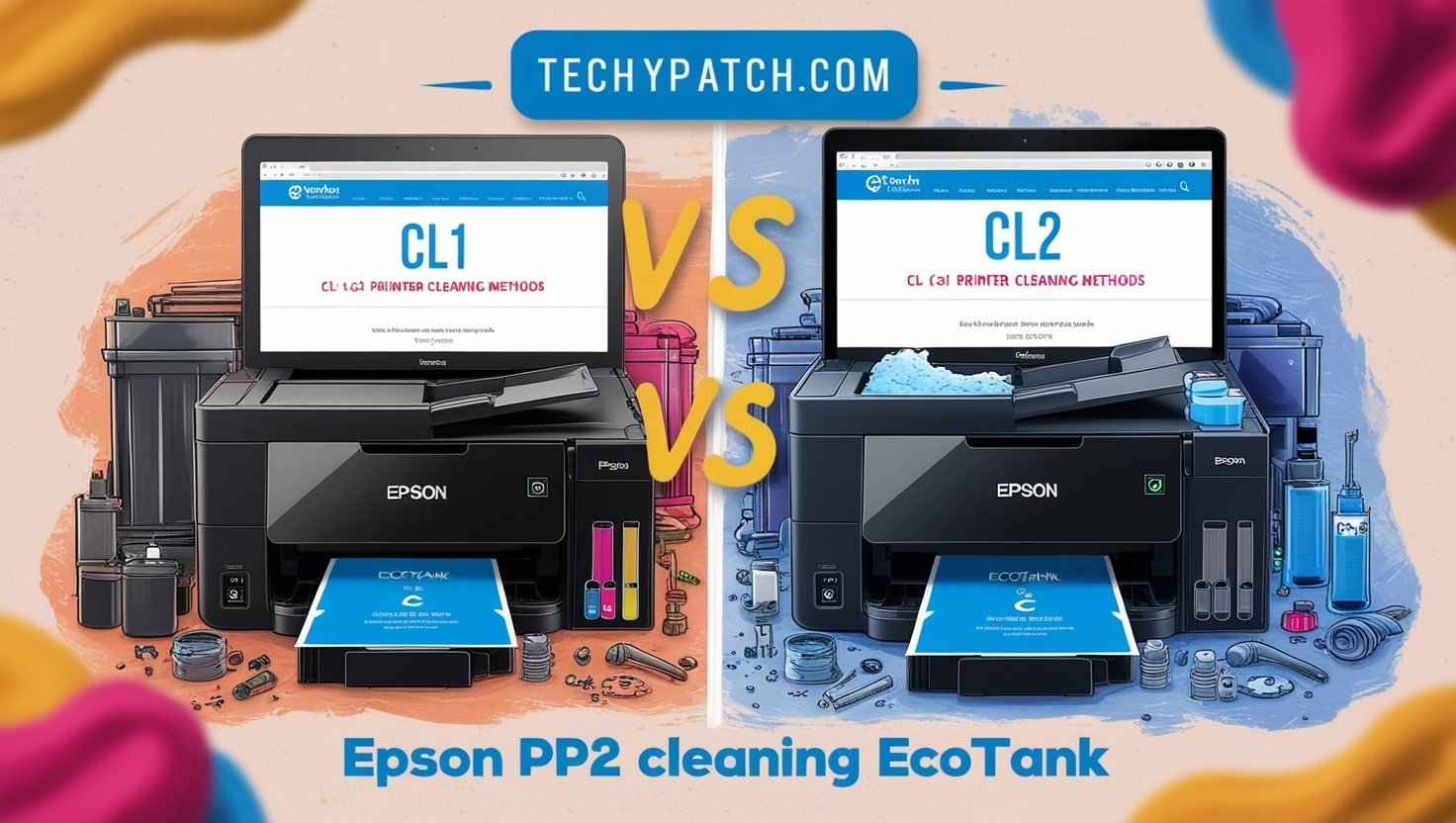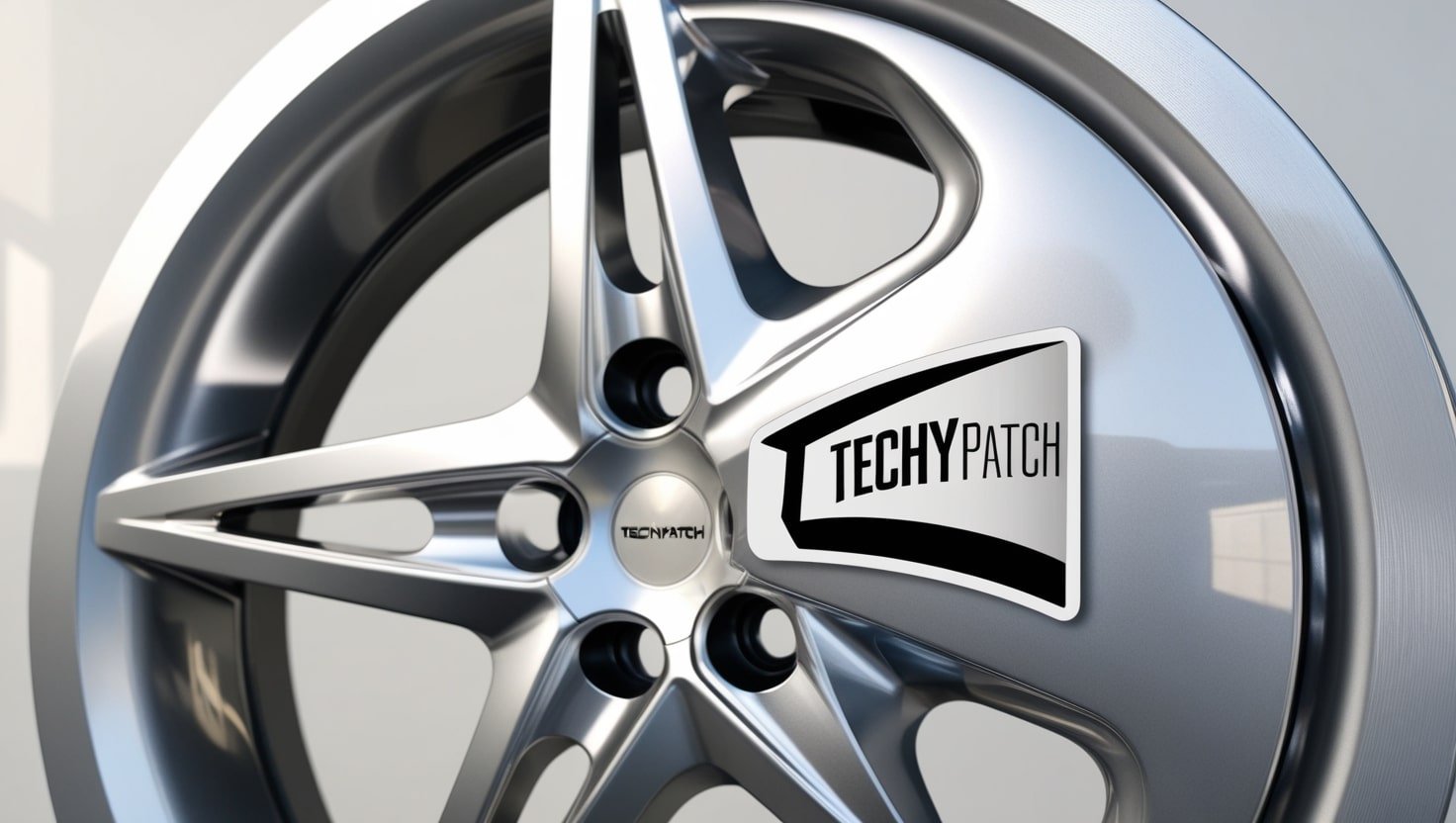Epson EcoTank printers have revolutionized the way we print, offering a more cost-effective solution compared to traditional ink cartridges. However, like any printer, regular maintenance is essential to ensure that your device operates smoothly and delivers high-quality prints. One common maintenance task that Epson EcoTank owners encounter is the cleaning process, specifically the CL1 vs CL2 cleaning Epson printer EcoTank. In this article, we will explore the differences between these two cleaning modes, their benefits, and how to choose the right cleaning method for your Epson EcoTank printer.
What is CL1 vs CL2 Cleaning Epson Printer EcoTank?
Before diving into the details of CL1 vs CL2 cleaning Epson printer EcoTank, it’s important to understand what these cleaning options are. Both CL1 and CL2 are different cleaning cycles designed to resolve issues related to clogged print heads and poor print quality. They are available on Epson EcoTank printers to help maintain the printer’s performance, ensuring you continue to get high-quality prints without excessive ink wastage.
CL1 Cleaning: The Basic Cleaning Mode
CL1 cleaning Epson printer EcoTank is the first-level cleaning cycle, designed for minor issues with the printer’s print heads. If you notice faint prints, horizontal streaks, or incomplete prints, the CL1 cleaning Epson printer EcoTank may be your first line of defense. It’s a quick and simple cleaning mode that uses a small amount of ink to clear minor blockages in the print heads.
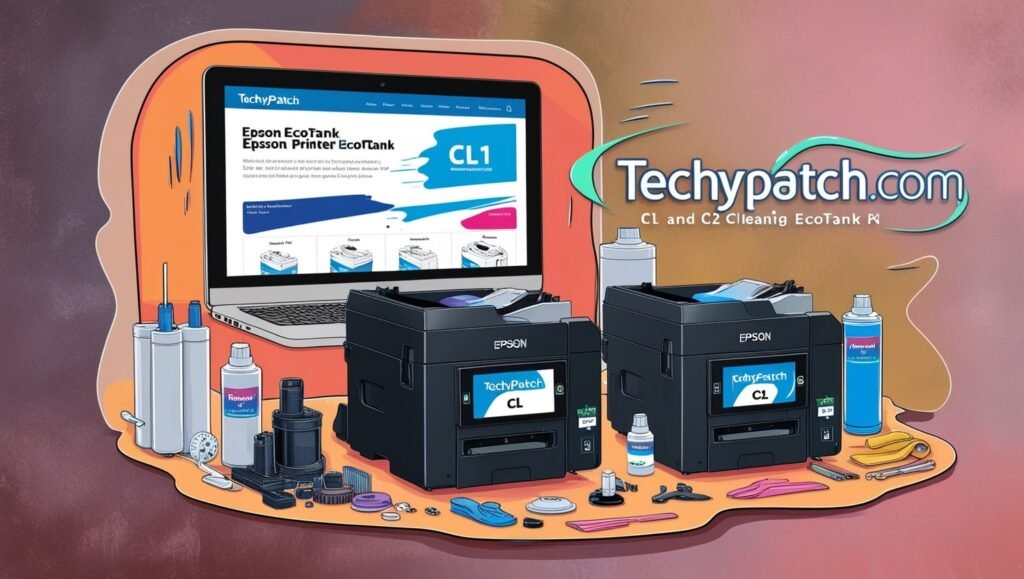
This mode typically works well if your printer has not been used for a while or if you’ve recently replaced the ink. The CL1 cleaning Epson printer EcoTank is ideal for addressing minor ink clogs and improving print quality without wasting too much ink.
CL2 Cleaning: A Deeper Cleaning Cycle
On the other hand, CL2 cleaning Epson printer EcoTank is a more intensive cleaning cycle. If CL1 cleaning Epson printer EcoTank doesn’t resolve the issue, or if you notice persistent problems such as ink smudges, color inconsistencies, or severe clogging, CL2 cleaning Epson printer EcoTank is the next step. The CL2 cleaning Epson printer EcoTank uses more ink than the CL1 cycle, and it works by applying a stronger cleaning solution to remove stubborn clogs in the printer heads.
The CL2 cleaning Epson printer EcoTank cycle is more effective for deep cleaning but also consumes more ink, so it should be used sparingly. It is recommended for situations where CL1 cleaning Epson printer EcoTank has failed to improve print quality or when you notice significant print head blockages.
When to Use CL1 Cleaning vs CL2 Cleaning Epson Printer EcoTank
Knowing when to use CL1 vs CL2 cleaning Epson printer EcoTank depends on the severity of the printing issue you’re experiencing.
Use CL1 Cleaning When:
- You notice faint or light prints that may indicate minor ink blockages.
- There are small horizontal lines or streaks in your prints, but the color is still relatively accurate.
- The printer has been sitting idle for a while and the ink may have dried up.
- You’ve just installed new ink tanks, and the printer is struggling to prime the heads.
In these cases, CL1 cleaning Epson printer EcoTank is a great first step. It uses minimal ink and should be enough to fix minor issues, especially if the problem is related to occasional clogging or dried ink in the print heads.
Use CL2 Cleaning When:
- CL1 cleaning Epson printer EcoTank doesn’t resolve the issue after several attempts.
- Your prints have visible ink streaks or blotches, indicating deeper clogging.
- Colors are uneven or there are blank spots on your prints despite performing basic cleaning.
- The printer’s nozzles are severely blocked, and you’ve been using it intermittently with long gaps between printing sessions.
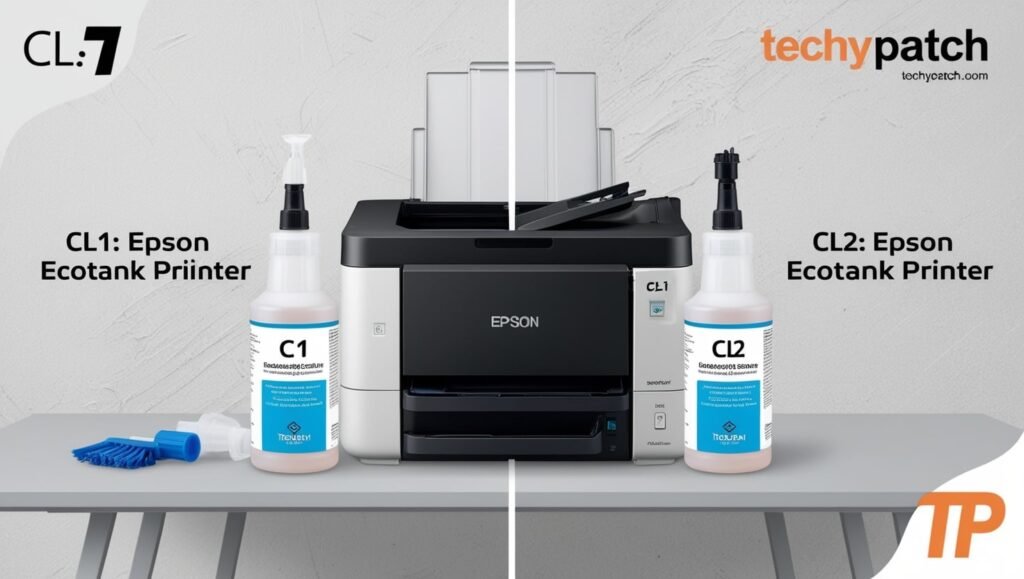
If you’re dealing with significant issues like these, CL2 cleaning Epson printer EcoTank is necessary. While it uses more ink, it’s more thorough and will help clear out stubborn ink blockages that CL1 cleaning Epson printer EcoTank cannot address.
The Cleaning Process: CL1 vs CL2 Cleaning Epson Printer EcoTank
The cleaning process for both CL1 vs CL2 cleaning Epson printer EcoTank is relatively simple, and it can be done directly from the printer’s control panel or through your computer’s software interface. Here’s an overview of how to perform each cleaning cycle:
How to Perform CL1 Cleaning
- Turn on the printer: Make sure your Epson EcoTank printer is powered on and connected to your computer or network.
- Access the cleaning menu: On the printer’s control panel, navigate to the maintenance or setup menu. Select the cleaning option and choose CL1 cleaning Epson printer EcoTank.
- Initiate the cleaning cycle: Once you select CL1 cleaning Epson printer EcoTank, the printer will start the process. This can take a few minutes, and the printer will use a small amount of ink to clean the print heads.
- Check the results: After the cleaning cycle completes, print a test page to check if the issue has been resolved. If the print quality has improved, the CL1 cleaning Epson printer EcoTank was sufficient.
- Repeat if necessary: If the issue persists, you can repeat the CL1 cleaning Epson printer EcoTank cycle. However, if there’s no improvement, it may be time to try CL2 cleaning Epson printer EcoTank.
How to Perform CL2 Cleaning
- Turn on the printer: Make sure the printer is on and connected.
- Access the cleaning menu: Again, go to the maintenance or setup menu on the printer’s control panel or use the software interface.
- Select CL2 cleaning: Choose CL2 cleaning Epson printer EcoTank. This will initiate the more intensive cleaning process, which can take a bit longer than CL1.
- Monitor the cleaning process: The printer will use more ink during this cycle, so be prepared for ink usage to be higher. Let the cycle complete without interruption.
- Test print: After the cleaning process is done, print a test page to evaluate the results. If the print quality has improved significantly, then CL2 cleaning Epson printer EcoTank has worked.
- Repeat if needed: If there are still issues, you may need to repeat the CL2 cleaning Epson printer EcoTank process, although doing so too many times may lead to unnecessary ink waste.
The Impact of CL1 vs CL2 Cleaning Epson Printer EcoTank on Ink Usage
One of the most significant factors when choosing between CL1 vs CL2 cleaning Epson printer EcoTank is ink usage. Since CL2 cleaning Epson printer EcoTank uses more ink than CL1 cleaning Epson printer EcoTank, it’s essential to be mindful of your ink levels, especially if you have limited ink remaining.
The CL1 cleaning Epson printer EcoTank cycle is designed to use minimal ink, making it a more cost-effective choice for routine maintenance. If your printer is having minor printing issues or if it has been sitting unused for a while, CL1 cleaning Epson printer EcoTank is likely to suffice without draining too much ink.
In contrast, CL2 cleaning Epson printer EcoTank is a more intensive process that uses more ink to clear severe clogs. If you have persistent issues with ink smudging, missing colors, or significant print head blockages, CL2 cleaning Epson printer EcoTank might be necessary. However, it’s recommended to use CL2 cleaning Epson printer EcoTank sparingly to avoid unnecessary ink consumption.
Preventing the Need for CL1 vs CL2 Cleaning Epson Printer EcoTank
To minimize the frequency of needing CL1 vs CL2 cleaning Epson printer EcoTank, it’s essential to take proactive steps in maintaining your printer. Here are some tips to prevent clogged print heads and poor print quality:
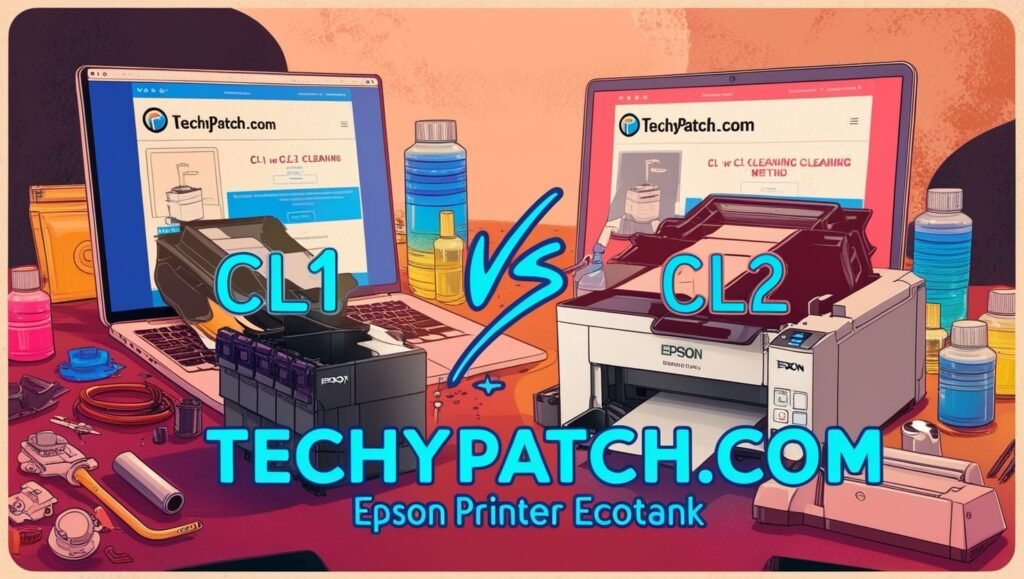
- Use the printer regularly: One of the main causes of ink clogs is prolonged periods of inactivity. Try to print at least once a week to keep the ink flowing through the print heads and prevent drying.
- Keep the printer covered: Dust and debris can cause clogs and interfere with print quality. Always keep your printer covered when not in use to protect it from dust buildup.
- Use high-quality ink: Make sure to use the recommended ink for your Epson EcoTank printer. Using low-quality or non-Epson ink can lead to clogs and other issues that may require CL1 vs CL2 cleaning Epson printer EcoTank.
- Perform regular maintenance: Instead of waiting for issues to arise, perform regular cleaning cycles to keep the print heads in good condition. This can help avoid the need for intensive cleaning like CL2 cleaning Epson printer EcoTank.
Conclusion
The CL1 vs CL2 cleaning Epson printer EcoTank debate boils down to the severity of the issue you’re facing. CL1 cleaning Epson printer EcoTank is ideal for minor clogs and routine maintenance, while CL2 cleaning Epson printer EcoTank should be reserved for more severe blockages. Understanding the difference between the two cleaning modes will help you make informed decisions about your printer’s maintenance needs.
Remember, CL1 cleaning Epson printer EcoTank uses less ink and is a great first step, while CL2 cleaning Epson printer EcoTank provides a deeper clean but consumes more ink. Regular maintenance and mindful ink usage will keep your Epson EcoTank printer running smoothly for years to come. Whether you need CL1 vs CL2 cleaning Epson printer EcoTank, knowing when and how to use each cycle will ensure optimal print performance and long-lasting results.
